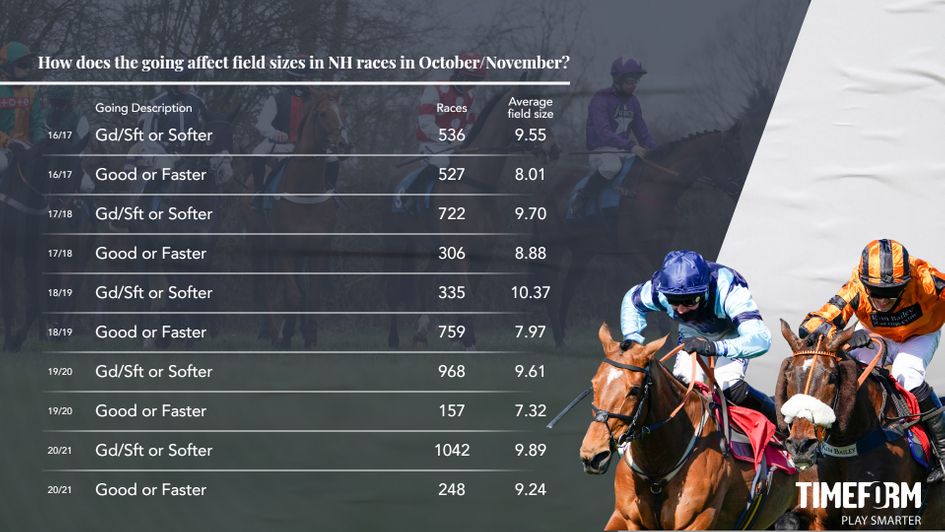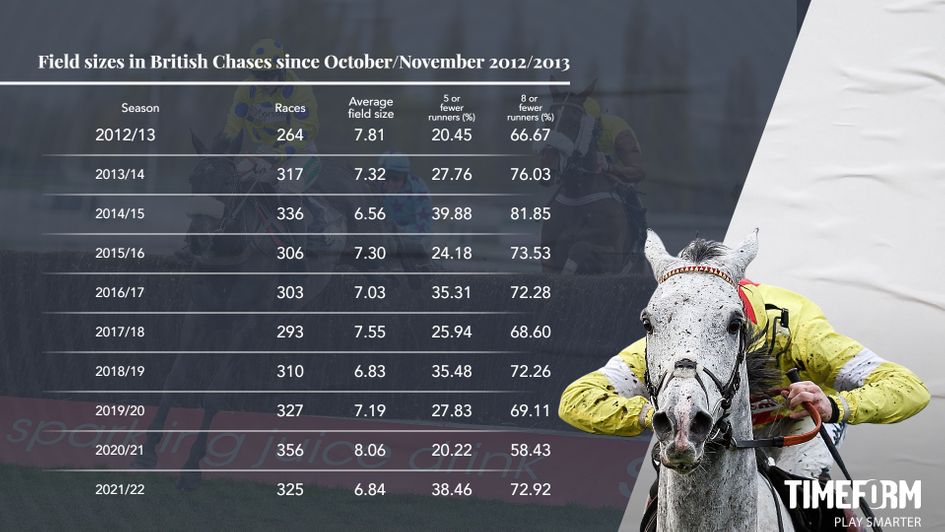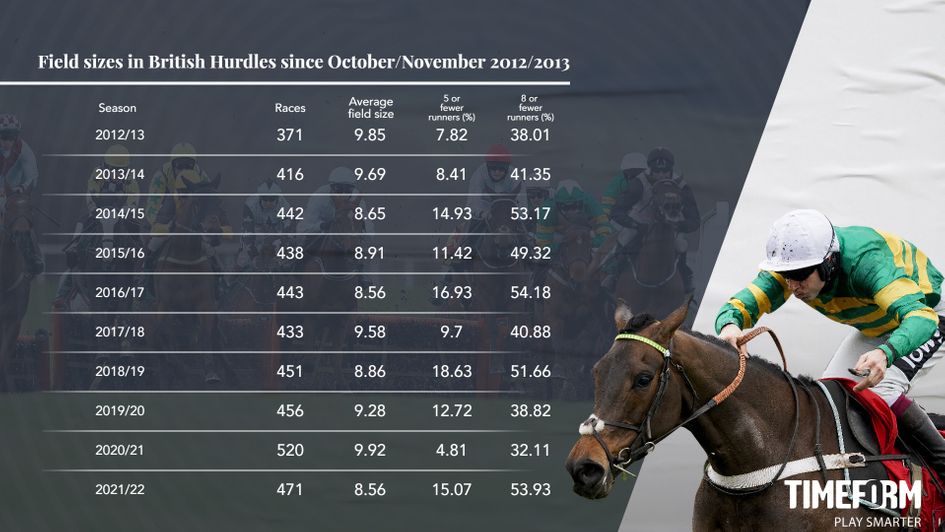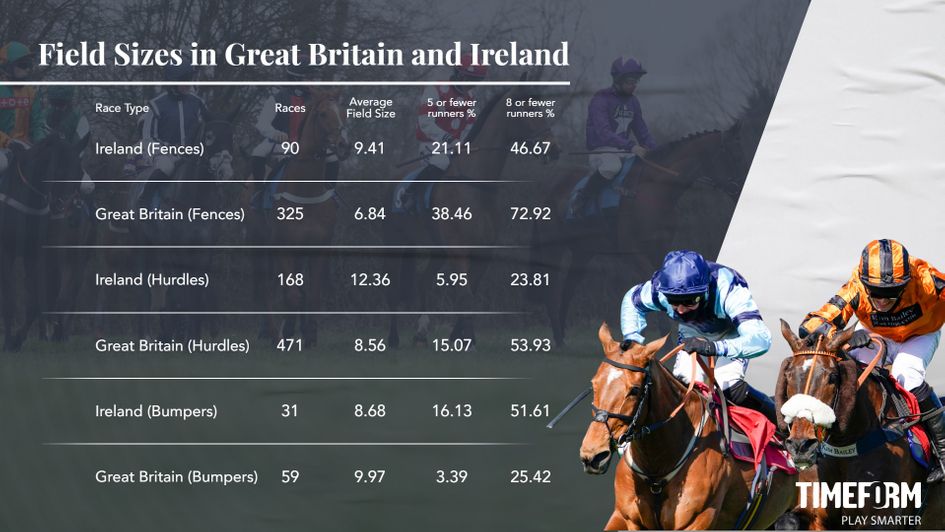Adam Houghton addresses the hot topic of field sizes by comparing how the data for the current National Hunt campaign stacks up compared to that from years gone by.
Plenty of column inches have been devoted to the issue of small fields in recent weeks, with the November Meeting at Cheltenham – one of the first showpiece fixtures in the National Hunt calendar – proving a significant flashpoint in the discussion.
It’s not hard to see why. After all, the meeting staged 18 races over the course of three days and fewer than eight runners went to post in seven of them, including in four of the six races on the Sunday card. Thankfully, the valuable Greatwood Hurdle deviated from the pattern on that particular afternoon, but the other five contests attracted a total of 25 runners between them.
The most disappointing example at Cheltenham was the novice chase in which the Dan Skelton-trained My Drogo, sent off the 9/4-on favourite, faced only one rival in the shape of Irish raider Gin On Lime.
As luck would have it for the ITV cameras, the race itself arguably served up more drama than any other during the course of the weekend, but the very make-up of it was still far from satisfactory, as discussed on Sporting Life’s Racing Podcast in the build up to the meeting.
“Lots of people will go to Cheltenham, they have an incredibly devoted fanbase,” summarised Graham Cunningham. “They’ll flock through the gates, they’ll be waiting outside, and they won’t be too fretful. But overall, it’s not healthy for the game.
“You have to try to find some solution to get those two and three-runner races – with 3/1-on or 7/2-on favourites – up to five, six or seven runners. You can’t automatically make them each-way races, but something has to be done.
“The whole game is so reliant on a very small handful of trainers to provide the seed corn for those races. I haven’t got a solution – I wish I had any sort of idea that would improve the situation – but a fantastic sport and an amazing brand is being held back if you have a three-runner race smack in the middle of the programme."
Of course, the November Meeting has been far from alone in this regard and it’s the poor turnout for fixtures all around Britain recently which has given cause for such concern.
Remember there was one card at Kempton in November where only 31 runners took part in the six races, with the four favourites who obliged all doing so at odds no greater than 2/1.
Going makes the difference in small fields debate
The recent dry spell probably hasn’t helped matters given that so many National Hunt trainers seem unwilling to risk their horses on anything other than so-called ‘proper winter ground’. It might well be that field sizes improve as soon as we see a bit more rain, a theory which is backed up by the data for all National Hunt races in Britain and Ireland in October/November this year.
During that period, the average field size for races on going described by Timeform as good or faster was 8.09, whereas the average field size for races on good to soft or softer going was 9.18.
69.62% of races (55/79) staged on good to firm going attracted eight or fewer runners, while 60.24% of races (203/337) staged on good going attracted eight or fewer runners. When you compare these percentages to those for races staged on good to soft (53.59% – 246/459), soft (37.27% – 60/161) and heavy (38.71% – 36/93), then it soon becomes apparent that the state of the ground can have a significant impact on field sizes at this time of year.
It’s worth pointing out that the data for previous years generally follows the same trend as the data for this one when it comes to the state of the ground. Indeed, when comparing the data for the five seasons between 2016/17 and 2020/21, races staged on good to soft or softer going in consistently perform best in terms of average field size – as the table below shows.

Incidentally, the data above also underlines the unpredictability of the weather and the challenges that it can present National Hunt trainers trying to plan for the season ahead. For example, there were no fewer than 759 races staged on good or faster going in October/November during the 2018/19 campaign, compared to just 157 races for the same two months of the 2019/20 season.
The going is just one consideration in this debate, though, and the big question is whether the small fields issue is a new threat to National Hunt racing or whether it’s always been this way and we’re only just opening our eyes to it and demanding change now? By comparing a variety of data from the last few years, again focusing solely on the months of October/November, we can hopefully get the answers that we’re looking for.
Cheltenham turnout symptomatic of a wider problem
Previous editions of the November Meeting at Cheltenham are a good place to start, a small sample size but a worthwhile one given the hysteria surrounding this year’s fixture where fewer than eight runners went to post in seven of the 18 races.
Interestingly, there were eight races which attracted similarly poor turnouts in 2018 and 2020, while there were seven in 2017 and five in 2019, when the meeting was held across two days after Friday’s card was abandoned due to a waterlogged track.
That would suggest that small fields are far from a new phenomenon at the November Meeting, but it goes without saying that there is a lot more to the National Hunt calendar than those three days at Prestbury Park. It’s a problem which runs much deeper than that and the overall data from October/November this year paints a particularly worrying picture for the programme in Britain.
It’s perhaps no coincidence that five of the seven races at the November Meeting with fewer than eight runners were chases. Historically, races over fences nearly always attract smaller fields than those over hurdles, but this year the turnout for races over the larger obstacles dipped even by their own standards.

In total, 325 races were run over fences in Britain in October/November this year, 72.92% (237/325) of which featured eight or fewer runners and 38.46% (125/325) of which featured five or fewer runners. The average field size for all 325 chases was 6.84.
What does that all tell us?
Well, not only did the average field size drop below seven for only the third time in the last decade, but it has also reached its lowest point since the 2014/15 season. That campaign was also the last time there was a greater percentage of chases in October/November with five or fewer runners taking part.
One thing that stayed much the same this year is the way that races over hurdles generally attracted more runners than races over fences, although they too suffered more with small fields than is often the case.

From 471 races run over hurdles in Britain in October/November this year, 53.93% (254/471) of them featured eight or fewer runners and 15.07% (71/471) of them featured five or fewer runners. The average field size for all 471 hurdle races was 8.56.
That average is as low as it has been at any other stage during the last decade, matching that of the 2016/17 season. That campaign was also the only time that there has been a comparable percentage of hurdle races in October/November with eight or fewer runners going to post.
The simple fact of the matter is that the small fields issue in Britain seems to be as bad now as it has been at any other stage in the last decade, at least for this time of year. The scale of the problem is even more stark when compared with the situation in Ireland, a contrast which is neatly demonstrated in the table below.

British fixture list at the heart of the fiasco
Put simply, races in Ireland over both fences and hurdles have been receiving far more support this year than those in Britain, not that the trainers based on the other side of the Irish Sea have much choice in the matter.
The fixture list in Ireland dictates that there is usually just one (and sometimes two) National Hunt fixtures being staged on any given day at this time of year. Finding suitable opportunities for a horse isn’t always easy, particularly in the novice ranks, so their connections are forced to run them where they can regardless of the quality and quantity of opposition they might come up against.
Of course, big fields and competitive racing don’t always go hand in hand – just watch the victory of All Class at Punchestown recently should you need a reminder of that point – but the Irish model certainly seems healthier and more sustainable than that in Britain.
On these shores the population of horses is way out of line with the bloated fixture list, making it too easy to duck and dive a tough race knowing that another option will be just around the corner. That together with the recent dry spell has left us dealing with a perfect storm resulting in even more small fields in Britain than we might typically expect at this time of year.
The weather might be totally out of our control, but the fixture list is a problem of our own doing and neither is it a new one following the odd warning shot during the last decade.
It cannot be allowed to continue if we are to ensure the best possible future for the sport of National Hunt racing in this country.
More from Sporting Life
Safer gambling
We are committed in our support of safer gambling. Recommended bets are advised to over-18s and we strongly encourage readers to wager only what they can afford to lose.If you are concerned about your gambling, please call the National Gambling Helpline / GamCare on 0808 8020 133. Further support and information can be found at begambleaware.org and gamblingtherapy.org.







